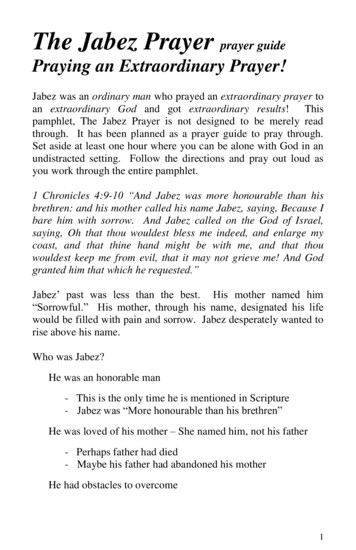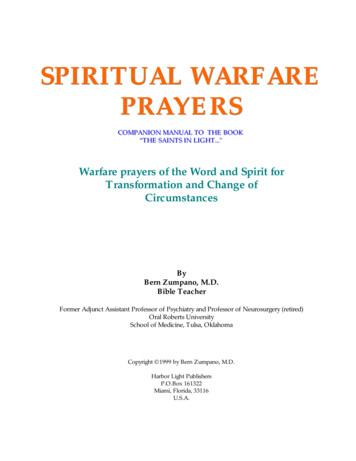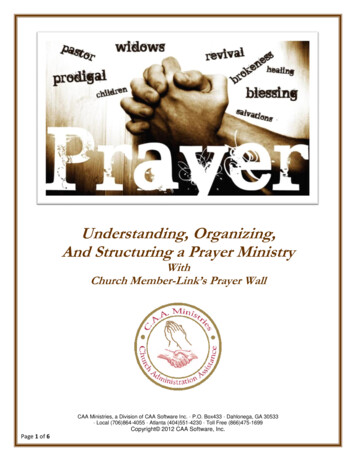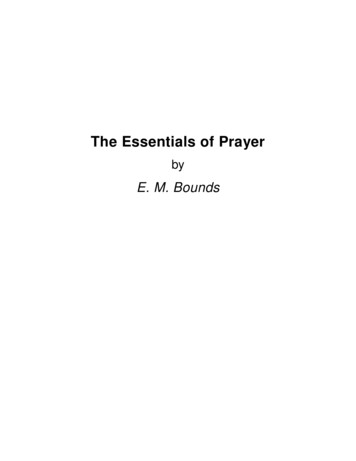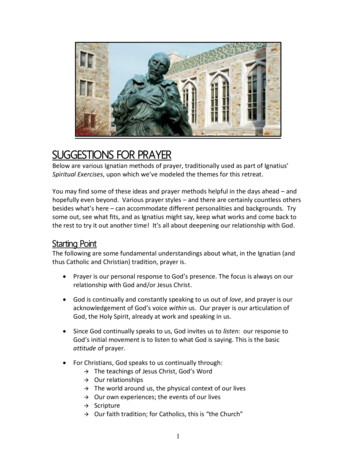
Transcription
SUGGESTIONS FOR PRAYERBelow are various Ignatian methods of prayer, traditionally used as part of Ignatius’Spiritual Exercises, upon which we’ve modeled the themes for this retreat.You may find some of these ideas and prayer methods helpful in the days ahead – andhopefully even beyond. Various prayer styles – and there are certainly countless othersbesides what’s here – can accommodate different personalities and backgrounds. Trysome out, see what fits, and as Ignatius might say, keep what works and come back tothe rest to try it out another time! It’s all about deepening our relationship with God.Starting PointThe following are some fundamental understandings about what, in the Ignatian (andthus Catholic and Christian) tradition, prayer is. Prayer is our personal response to God’s presence. The focus is always on ourrelationship with God and/or Jesus Christ. God is continually and constantly speaking to us out of love, and prayer is ouracknowledgement of God’s voice within us. Our prayer is our articulation ofGod, the Holy Spirit, already at work and speaking in us. Since God continually speaks to us, God invites us to listen: our response toGod’s initial movement is to listen to what God is saying. This is the basicattitude of prayer. For Christians, God speaks to us continually through: The teachings of Jesus Christ, God’s Word Our relationships The world around us, the physical context of our lives Our own experiences; the events of our lives Scripture Our faith tradition; for Catholics, this is “the Church”1
General Points for Intentional PrayerFrom the Ignatian perspective, again, God is always talking to us and prayer is ourresponse to God, letting God speak through us. That means that prayer doesn’t justhappen when we go through these, or any, specific, formal, structured steps – it isspontaneous too! God is spontaneous – so be sure to leave room for that too!Understanding that, here are some helpful things to consider when entering intointentional prayer:1. Plan out time for prayer – schedule it and stick to it2. Find a quiet place – your room, a chapel or any place where you won’t bedistracted or disturbed.3. Quiet yourself down – relax – set aside all other concerns – be conscious of thelife within you, your breathing, your heartbeat.4. Be conscious of God’s presence – in you and in the world around you – in thedeepest parts of yourself – in the Word that you read, if you’re using Scripture.5. Speak to God – thank God for this time – ask for what you want and need. Speakas a friend. Tell God what is on your mind.Da i ly Morning and Evening PrayerIn the morning, fairly soon after waking: Acknowledge God’s presence with you, and offer yourself to Him for the day. Ask for what you need during the day. Pray the Lord’s Prayer.In the evening Acknowledge God’s presence – God who has been with you throughout the day. Look back on the day to see how God has given you what you needed for the day. Express your gratitude to God. Pray the Lord’s Prayer.2
The ExamenThe Examen was St. Ignatius’ way of better knowing himself and God. Each step cantake only a few moments; the point is that it become a regular habit, the benefits ofwhich (a closer relationship with God, and ones’ self) manifest themselves over time.1. AWARENESSTake a moment to be calm; recognize that God is with you, wherever you are.2. HONESTYAsk God to help you to be truly honest with yourself as you pray now, and to be opento whatever God might have to show you.3. REVIEWAsk yourself, "When did I both genuinely love and feel loved today? These momentsreflect God’s presence in your day. Notice the circumstances of these moments andtake a moment to let them sink in. If you feel compelled to thank God, do so.What did you struggle with today? Recognize the times when you would say you“failed” during the day. Consider that these failures can be opportunities to hearGod’s voice in your life and ask, “How did these moments feel?” If you feelcompelled to express regret, do so, confident that God is ready to help.4. TALKImagine God, or Jesus, as your friend, sitting with you. Share, as you would with afriend, and in whatever way you would like, whatever strikes you about your reviewof the day. Consider taking some time to listen for a response.5. TOMORROWConsider what your day may hold tomorrow. Ask God for help as you face the nextday, and ask to recognize God’s presence as you go through your day.3
Centering prayer“Be still, and know that I am God” - Psalm 46:10Centering prayer is a simple, pure form of prayer, without words or with only very fewwords; it is an opening of our hearts to the Spirit dwelling within us. A standard time forthis is 20 minutes; make it whatever you’d like. Sit quietly, comfortable, and. relaxed.Acknowledge your desire to be with God.Move to the center within your deepest self. This movement can be facilitatedby imaging yourself slowly descending in an elevator, or walking down flights ofstairs, or descending a mountain, or going down into the water, as in a deeppool. In the stillness, become aware of God’s presence; peacefully absorb God’slove.Decide on a word or phrase that represents for you the fullness of God, e.g. love,peace, Jesus, a scriptural phrase. Repeat the word or phrase within yourself inharmony with your breathing.Be patient with distracting thoughts – they will certainly be present, especially ifthis form of prayer is new for you. Let them be; do your best to gently brushthem aside and not follow them. If and when you catch yourself following adistracting thought, simply repeat your mantra word/phrase and continue. Journa l i ngJournaling is meditative writing. When we place pen on paper, spirit and bodycooperate to release our true selves. There are many variations for the use of journalingin prayer: writing a letter addressed to God; writing a conversation between oneself and another; the other may be Jesus, oranother significant person. The dialogue can also be with an event, anexperience or a value. For example, death, separation or wisdom receivespersonal attributes and is imaged as a person with whom one enters intoconversation; writing an answer to a question, e.g., “What do you want me to do for you?”(Mk. 10:51) or “Why are you weeping?” (Jn. 20:15) allowing Jesus or another person from scripture to “speak” to us through the pen.4
USING SCRIPTUREChoose your own passage from scripture for any of the following four methods.Lectio Divina1. Read the Scripture passage prayerfully Listen for a word or phrase that stands out. Write down the word or the phrase. Take some time to reflect on the word or phrase.2. Read the passage again. Listen for a word or phrase that reflects what Christ may be saying to you. Write down the word or the phrase. Take some time to reflect on the word or phrase.3. Read the passage a third time. Listen for a word or phrase that best reflects your response to Christ. Write down the word or the phrase. Take some time to reflect on the word or phrase.4. Read all of the words and phrases you’ve written down.5. Talk to God, or Jesus, about what you notice, feel, and think as you read them.Share these with God and/or Jesus – and listen.Meditation1. Read the passage slowly, aloud or in a whisper, letting the words wash over you,savoring them.2. Stay with the words that especially catch your attention; one way to think aboutthis is to absorb them the way the thirsty earth receives the rain.3. Keep repeating a word or phrase, aware of the feelings that are awakened. Read,and reread the passage lovingly as you would a letter from a dear friend, or asyou would softly sing the chorus of a song.4. When a thought resonates deeply, stay with it. Respond authentically andspontaneously with God as in a dialogue and see what comes to you.5
Imaginative Prayer1. Slowly read and reread the designated passage from Scripture.2. Once you have become familiar with the text, put the it aside, and begin toimagine the story in detail, using as many of your five senses as you can:The setting: Imagine he scenery, the landscape, the environment: What doeseverything look like? What kind of day is it? What does the air, the area, even the people, smell like? Is there anything you can taste? What does the air, the ground, clothes, feel like?The people: Who are the characters? What do they look like? What are they doing? What has been happening to them in their lives?Hear: Listen to the narrated dialogue. Pay attention to their tone of voice. Imagine the thoughts and exchanges of the dialogue.3. Enter into conversational prayer with Christ or even with others in the scene.Talk as you would with someone physically present, and see what comes out.You could even speak with Jesus, or God about what you notice when doing this.Prayer of Consideration1.2.3.4.Slowly read and reread the designated text prayerfully.Consider the words, their meaning and what is implied.Ask Christ to teach you the deep meaning of the passage you are considering.Allow the text to draw your mind and heart to God the Father, God the Son, orGod the Holy Spirit.5. Consider the text and your growing understanding of it.6. Enter into conversation with the Father, the Son or the Holy Spirit in light of thetext you have considered and how it may influence the way you live the Christianlife.7. This conversation may take the form of gratitude, praise, petition or sorrow.6
AFTER PRAYER – SOME SUGGESTIONSReview of the PrayerAfter entering into a formal period of prayer, it can be beneficial for your own insightsto review what happened during that time. This means not so much reviewingnecessarily what ideas you had, but more the movements of your feelings: the joy,sadness, fear, anxiety, boredom, and so on – and even the distractions, especially if theywere deep or even disturbing.Some questions that may help: What went on during the period of prayer? What stays with you? How did you feel about what went on? What was your mood; did you notice changes in mood?This review is a way to help you reflect upon the experience of your formal prayerperiod. It may help you to notice your interior experiences, and it may enable you toeven also be spontaneous during the actual prayer time and to go with the flow ofexperience. Try not to monitor yourself during prayer, as this would be interfering withthe God’s communication. Let happen what is happening during the prayer time;afterwards, take a look to see what the Lord is saying in all this.It may be helpful during this review to jot down a few reflections that strike you so thatyou can more easily prepare for your next period of prayer. The Lord may be invitingyou to go back to a point where you were moved. St. Ignatius says, “I should remainquietly meditating upon a point until I have been satisfied” i.e., until the movement hasbeen completed (the insight completed; the struggle resolved; the meaningfulnessfinished . . . for now). Keep in mind that that may not come – and that’s o.k.!Jotting down your reflections during the review may also be helpful when you discussyour prayer experiences with a spiritual director.7
General Points for Intentional Prayer From the Ignatian perspective, again, God is always talking to us and prayer is our . Centering prayer is a simple, pure form of prayer, without words or with only very few . this is to absorb them the way the thirsty earth receives the rain. 3. K
